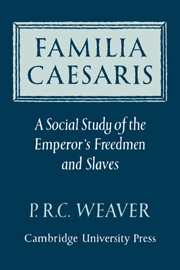Book contents
- Frontmatter
- Contents
- Preface
- Abbreviations
- INTRODUCTION
- PART I NOMENCLATURE AND CHRONOLOGY
- PART II THE FAMILY CIRCLE
- PART III THE EMPEROR'S SERVICE
- APPENDIXES
- 1 ‘Familia Caesaris’
- II Inscriptions of Imperial freedmen and slaves dated to a particular year or reign
- III Wives of Imperial freedmen and slaves
- Bibliography
- Index
1 - ‘Familia Caesaris’
Published online by Cambridge University Press: 07 October 2011
- Frontmatter
- Contents
- Preface
- Abbreviations
- INTRODUCTION
- PART I NOMENCLATURE AND CHRONOLOGY
- PART II THE FAMILY CIRCLE
- PART III THE EMPEROR'S SERVICE
- APPENDIXES
- 1 ‘Familia Caesaris’
- II Inscriptions of Imperial freedmen and slaves dated to a particular year or reign
- III Wives of Imperial freedmen and slaves
- Bibliography
- Index
Summary
‘Familia’ appears as early as the Twelve Tables (v. 4–5) in the sense of ‘household’ or all those persons under the potestas of the pater familias, including a wife in manu and a filius familias, as well as slaves. But in a narrower sense it referred specifically to slaves (famuli) in relation to their dominus. The potestas of the pater familias over his servus was the same as that which he exercised over his filius familias or wife in manu, and a qualitative distinction between patria potestas and dominica potestas should not be pressed. A pater familias is correctly so called even when he has no filius under his potestas (Dig. 1. 16. 195.2). The original household cult of the Lares presided over by the pater familias came to have a specifically slave connotation by the second century bc, and the slave vilicus came to represent the head of the household in the celebration of the cult.
By a natural extension of this meaning ‘familia’ also included manumitted slaves (liberti) in relation to their patron, e.g. Dig. l. 16. 195.1 (Ulpian): ‘ad personas autem refertur “familiae” significatio ita cum de patrono et liberto loquitur lex’. Cf. Pauli Sent. v. 1.3:’ ex officio fisci inter fiscalem familiam’. In inscriptions liberti are commonly assumed to be part of a given familia, especially in the collegium familiae and in columbaria for purposes of worship or burial, e.g. VI 479 = XIV 32 = d 6152: ‘corpori familiae public(a)e libertorum et servorum’; cf. VI 10107 = d 5212,10257,10258, etc.
- Type
- Chapter
- Information
- Familia CaesarisA Social Study of the Emperor's Freedmen and Slaves, pp. 299 - 300Publisher: Cambridge University PressPrint publication year: 1972



